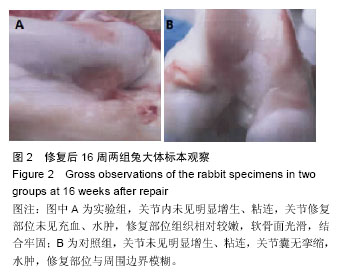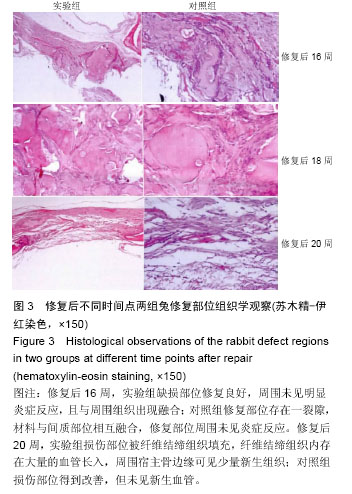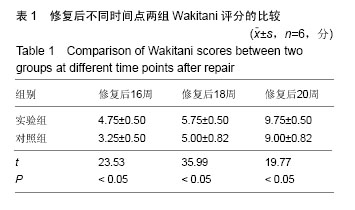| [1] Vo N,Niedernhofer LJ,Nasto LA,et al.An overview of underlying causes and animal models for the study of age-related degenerative disorders of the spine and synovial joints.J Orthop Res. 2013;31(6):831-837.
[2] Capeci CM,Turchiano M,Strauss EJ,et al.Osteochondral allografts: applications in treating articular cartilage defects in the knee.Bull Hosp Jt Dis. 2013;71(1):60-67.
[3] 张仲文,侯世科,杨造成,等.基质诱导的自体软骨细胞移植术修复膝关节软骨缺损10例术后2年的随访[J].中华关节外科杂志(电子版),2010,4(6):17-21.
[4] 张永涛,金丹.组织工程骨软骨复合体构建的研究进展[J].中国修复重建外科杂志,2011,25(9):1120-1124.
[5] Komárek J,Vali P,Repko M,et al.Treatment of deep cartilage defects of the knee with autologous chondrocyte transplantation: long-term results.Acta Chir Orthop Traumatol Cech. 2010;77(4):291-295.
[6] Lim HC,Bae JH,Song SH,et al.Current treatments of isolated articular cartilage lesions of the knee achieve similar outcomes.Clin Orthop Relat Res. 2012;470(8): 2261-2267.
[7] 李元城,张卫国,秦建华,等.微流控芯片上胰岛素样生长因子1和碱性成纤维细胞生长因子对兔关节软骨细胞增殖的影响[J].解放军医学杂志,2013,38(6):476-480.
[8] Schwarz S,Koerber L,Elsaesser AF,et al.Decellularized cartilage matrix as a novel biomatrix for cartilage tissue-engineering applications.Tissue Eng Part A. 2012;18(21-22):2195-2209.
[9] Cheng H,Byrska-Bishop M,Zhang CT,et al.Stem cell membrane engineering for cell rolling using peptide conjugation and tuning of cell-selectin interaction kinetics.Biomaterials.2012;33(20):5004-5012.
[10] 刘清宇,王富友,杨柳.关节软骨组织工程支架的研究进展[J].中国修复重建外科杂志,2012,26(10):1247-1250.
[11] 贵浩然,李澎,张卫国.制备软骨组织工程支架的材料和方法[J].中国组织工程研究,2013,17(3):509-516.
[12] 梁卫东,王宏伟,王志强.不同骨组织工程支架材料的生物安全性及性能[J].中国组织工程研究与临床康复, 2010, 14(34):6385-6388.
[13] Salzmann GM,Sah BR,Schmal H,et al.Microfracture for treatment of knee cartilage defects in children and adolescents.Pediatr Rep.2012;4(2):e21.
[14] Ebert JR,Robertson WB,Woodhouse J,et al.Clinical and magnetic resonance imaging-based outcomes to 5 years after matrix-induced autologous chondrocyte implantation to address articular cartilage defects in the knee.Am Sports Med.2011;9(4):753-763.
[15] Hirschmuller A,Baur H,Braun S,et al.Rehabilitation after autolo- gous chondrocyte implantation for isolated cartilage defects of the knee.Am J Sports Med. 2011; 39(12): 2686-2696.
[16] Wondrasch B,Zak L,Welsch GH,et al.Effect of accelerated weight bearing after matrix-associated autologous chondrocyte implantation on the femoral condyleon radiographic and clinical outcome after 2 years: a prospective,randomized controlled pilot study.Am Sports Med.2009;37(Supp1):88S-96S.
[17] Pestka JM,Schma H,Salzmann G,et al.In vitro cell quality of articular chondrocytes assigned for autologous implantation in dependence of specific patient characteristics.Arch Orthop Trauma Surg. 2011;131(6):779-789.
[18] 钟进聪,王震.大众体育与竞技体育运动损伤的成因及对策[J].广州体育学院学报,2014,34(1)109-111.
[19] 张卉,董学君,邵健忠,等.改良人骨髓间充质干细胞分离方法提高细胞定向分化能力[J].医学研究杂志, 2010, 39(9): 57-62.
[20] Alves da Silva ML,Martins A,Costa-Pinto AR,et al. Chondrogenic differentiation of human bone marrow mesenchymal stem cells in chitosan-based scaffolds using a flow-perfusion bioreactor.J Tissue Eng Regen Med.2010;12:29.
[21] 朱雷,吕丹.不同环境刺激对骨髓间充质干细胞成软骨分化作用的研究进展[J].中国矫形外科杂志, 2010,18(19): 1618-1621.
[22] 杨波,胡蕴玉.胶原/羟基磷灰石骨软骨一体化支架的生物学特性研究[J].中国矫形外科杂志, 2010,18(4):304-307.
[23] 张文元,杨亚冬,房国坚,等.壳聚糖-丝素复合支架材料与骨髓间充质干细胞相容性的研究[J].中国卫生检验杂志, 2010,20(12):3084-3086.
[24] 梅晰凡,袁亚江,吕刚,等.BMP-2诱导肌源性干细胞转化为软骨样细胞的体外实验研究[J].中国医科大学学报, 2009, 38(2):92-95.
[25] 李丽艳,黄金中,杜江,等.转化生长因子β1诱导骨髓间充质干细胞向软骨细胞分化[J].中国组织工程研究与临床康复,2010,14(1):38-41.
[26] Saris D,Vanlauwe J,Victor J,et al.Characterized chondrocyte implantation results in better structural repair when treatingsymptomatic cartilage defects of the knee in a randomized controlled trial versus microfracture.Am J Sports Med.2008;36(2):235-246.
[27] 谭洪波,杨柳.局部关节软骨和骨软骨损伤修复策略的研究进展[J].中华关节外科杂志:电子版,2010,4(6):795-803.
[28] Adkisson HD,Milliman C,Zhang X,et al.Immune evasion by neocartilage derived chondrocytes: Implications for biologic repair of joint articular cartilage. Stem Cell Res.2010;4(1):57-68.
[29] Tompkins M,Hamann JC,Diduch DR,et al.Preliminary Results of a Novel Single-Stage Cartilage Restoration Technique: Particulated Juvenile Articular Cartilage Allograft for Chondral Defects of the Patella. Arthroscopy. 2013;29(10):1661-1670.
[30] Haleem AM,Singergy AA,Sabry D,et al.The Clinical Use of Human Culture-Expanded Autologous Bone Marrow Mesenchymal Stem Cells Transplanted on Platelet-Rich Fibrin Glue in the Treatment of Articular Cartilage Defects:A Pilot Study and Preliminary Results. Cartilage.2010;1(4):253-261.
[31] Kim K,Lam J,Lu S,et al.Osteochondral tissue regeneration using a bilayered composite hydrogel with modulating dual growth factor release kinetics in a rabbit model. J Control Release.2013;168(2):166-178.
[32] 刘利兵,王成伟,高健,等.微骨折技术与骨软骨移植治疗关节软骨缺损[J].中国组织工程研究, 2013,17(31):5735- 5740.
[33] 孟晔,林治琳,柳硕柱,等.关节镜下自体骨软骨移植治疗股骨软骨损伤:1-4年随访结果[J].中国组织工程研究与临床康复,2009,13(31):6055-6058.
[34] 左镇华,杨柳,段小军,等.关节镜下微骨折技术治疗膝关节软骨缺损的近期临床疗效评价[J].重庆医学, 2006, 35(20): 1834-1836.
[35] Toh W,Lee EH,Guo XM,et al.Cartilage repair using hyaluronan hydrogel-encapsulated human embryonic stem cell-derived cells.Iornaterials. 2010;31(27): 6968-6980.
[36] 伏治国,瞿玉兴.关节镜下自体镶嵌式骨软骨移植修复膝关节股骨髁软骨缺损[J].实用医学杂志, 2011,27(22): 4094-4095.
[37] Hangody L,Fules P.Autologous osteochondral mosaicplasty for the treatment of full-thickness defects of weight bearing joints:ten years of experimental and clinical experience.J Bone Joint Surg Am. 2003;85(s2): 25-32. |
.jpg)



.jpg)
.jpg)
.jpg)